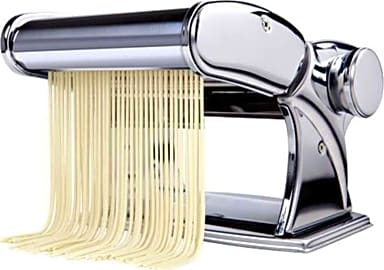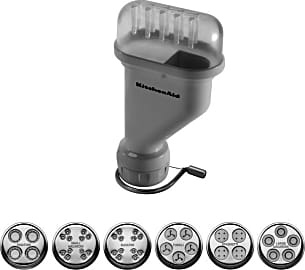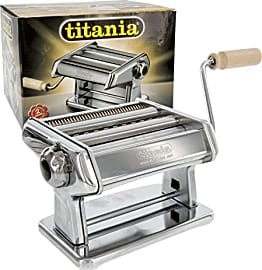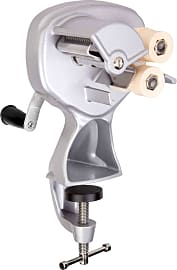The 10 Best Pasta Makers

This wiki has been updated 43 times since it was first published in April of 2015. Sure, it's easy to use the dry stuff that comes in countless varieties on the shelves of every supermarket in the world, but there's nothing like fresh, homemade pasta. Although it is time-consuming, the right machine will do most of the work for you. Our selections come with various sizes of rollers and blades to produce any shape of noodle your heart desires. When users buy our independently chosen editorial recommendations, we may earn commissions to help fund the Wiki.
Editor's Notes
December 11, 2019:
Nothing quite compares to the fresh scent, taste, and texture of homemade pasta. While a quality pasta maker and helpful accessories like drying racks can be essential to creating the perfect dish, the key to the entire operation is getting the dough just right. Plenty of beginners who have yet to perfect their recipes will often blame the machine for a poor result, but the truth is, you're going to have to make a mess and likely create a few less-than-stellar meals until you get things right.
We think the newly-added iSiler Silver B is a great choice for those who are just starting to work with pasta since it's crafted from an aluminum alloy that you can actually wash. The OxGord KAPM-01 also boasts dishwasher-safe components. Many similar machines can never be submerged in water, which makes cleaning a pain when you've been experimenting with different dough types. In the beginning, your dough might be gummy or sticky, so having a unit you can rinse out is paramount.
Also joining the ranks today is the CucinaPro Authentic and Shule Streamline, two more great introductory models with economical price tags. We added another electric option in the Imperia Presto, a durably-made Italian unit ideal for households that produce large quantities of pasta regularly for family and friends. It has two built-in cutters for tagliatelle and fettuccine, is extremely easy to use and care for, and is no louder than a standard mixer. To make room for these models, we said goodbye to the Fox Run Craftsmen due to confirmed quality complaints, as well as the Meglio Ultra, Gourmia GPM100, and Gourmia GPM500, which became unavailable.
Special Honors
Smart Pasta Maker If you make pasta often and are looking for a machine to streamline that process, consider Smart's electric pasta maker. This machine is intuitive to use and boasts a clear LED display and soft-touch controls. With its knead dough function and patented blade, it can make dough directly from flour and water for bread, cakes, cookies, and all types of pasta. The machine also sports a vertical extrusion to prevent any jamming, as well as a fan that dries noodles during production to make them easier to cook. smartworldwidefun.com
Avancini Tabletop Pasta Machine Capable of making well over eight pounds of pasta per hour, the notably expensive Avancini Tabletop is made for commercial use in Italian markets, restaurants, and supermarkets. It has a compact, tabletop design and uses its powerful motor to provide high yields in a space-saving footprint. It comes with three dies for making spaghetti, linguine, and fettuccine. Simply load ingredients into the 3.3-pound hopper and let the machine do the rest. webstaurantstore.com
The Sacred Wheat
Growing up in an Italian-American household, my family was Roman Catholic by default.
Growing up in an Italian-American household, my family was Roman Catholic by default. In our hearts, though, you could say we worshiped pasta. I definitely spent more of my childhood turning a fork through a pile of spaghetti than I spent contemplating the beatitudes.
The pasta of those days had already begun a dangerous transformation. By the time I was born, certain companies bent on increasing crop yields at the cost of long-term soil and water quality, and most importantly, at the cost of their consumers' health and wellness took to modifying the genetic makeup of their wheat crops.
Genetically modified wheat is a gross mutation of the primary ingredient in pasta that my ancestors enjoyed for so many centuries. It's literally been mutated by blasts of radiation to make it more invulnerable to things like pesticides, herbicides, and fungicides that reduce workloads on farms and save big agricultural firms countless millions of dollars. It's like a bad superhero story in which, instead of gaining powers by his or her exposure to radiation, a character becomes toxic. It's the origin story of a supervillain.
All this is why, at a time like this, it's almost imperative that you make your own pasta. It's a blinding coincidence that incidences of Celiac disease and gluten intolerance have emerged in perfect conjunction with the evolution of GMO wheat products and their attendant chemical agents.
Having a pasta maker vice-locked into place against your countertop allows you to take complete control over the ingredients that go into you pasta, to use non-GMO wheat products and to make a tastier dinner than you could have ever imagined.
That is, perhaps, the most appealing thing about a pasta maker. By simply creating your own pasta dough and feeding it through these machines, letting the rollers on one attachment flatten out the dough, and the rollers of another pull the flat dough through teeth spaced to cut it into long strips, you get to experience a flavor that no store-bought pasta could possibly give you. The freshness, the texture, and the taste of fresh pasta is unparalleled, and its health benefits compared to the stuff in the box is undeniable.
The Plug Or The Hand?
At first glance, it might not seem like there are a lot of differences among the pasta makers on our list. To a certain extent that's true. Pasta makers are mostly uniform due to a kind of perfection in their mechanical design. Other attempts at more unique or innovative pasta makers have all fallen flat through the years because this design is so simple and so effective.
That said, there are some important differences for you to consider before making your purchase, not least of which is whether to go with a manually operated pasta maker or an electric one.
Part of the decision between them is practical: do you want to do that little bit of extra work to attain your perfect pasta?
Manually operated pasta makers require you to crank a large handle to turn the rollers that feed your dough through the maker. You don't need to be particularly musclebound to perform the operation, but you might start to feel it in your shoulder if you're at the task long enough. Electric pasta makers on the other hand have small, powerful motors built into them that operate the rollers, feeding the dough through automatically.
Part of the decision between them is practical: do you want to do that little bit of extra work to attain your perfect pasta? Another part of it, though, is aesthetic: do you want to adhere more closely to the traditional mechanical method of making pasta, or are you comfortable handing that task over to the machine entirely?
Personally, the workload on a manual maker is so light, and the reward feels so much greater, that I opt to do it by hand. If you have issues with arthritis or joint problems, or if you need to make larger quantities of pasta in a sitting, the electric models are the way to go. But you're going to spend some time making this dough from scratch, pouring a good deal of your heart and soul into the mix as you go, so I think it's best to stay as directly involved with the process as possible until the very end.
East To West
Bits of historical evidence, loose references, legends, and flat out lies season the origins of pasta like so many bits of Parmesan cheese. References to a food known as lagana in the first few Common Era centuries imply that the food was a kind of precursor to lasagna, as it consisted of flat sheets of fried dough which, in some cases, would be layered and stuffed with meat.
The pasta maker itself has equally cloudy origins, as the noodles were primarily made by hand for so many years.
The thin strips of such dough we associate with pasta and the pasta makers on this list were likely an Arabic invention from roughly the fifth century. Some records imply that the Emirate of Sicily first encountered pasta at the hands of Arabs in the ninth century.
Then, there's the legend of Marco Polo, who supposedly traveled to China in the thirteenth and fourteenth centuries and brought the concept of the noodle to the dough used in lagana and other Italian dishes of the time. There isn't a lot of evidence to back up this particular legend, unfortunately.
The pasta maker itself has equally cloudy origins, as the noodles were primarily made by hand for so many years. There is one reference in Greek mythology to a device Hephaestus used to make strings of dough, but mechanical pasta making didn't have a place on the scene until some time in the 1700s.
Late in that century, Thomas Jefferson brought back a pasta maker from France and eventually created a few of his own. In the 1800s, emigration to the United States from Italy began a steady rise that would bring all the delicious cuisine of the peninsular nation to American shores.















